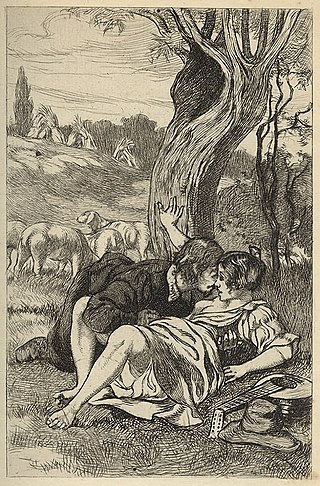Related Research Articles
Erectile dysfunction (ED), also referred to as impotence, is a form of sexual dysfunction in males characterized by the persistent or recurring inability to achieve or maintain a penile erection with sufficient rigidity and duration for satisfactory sexual activity. It is the most common sexual problem in males and can cause psychological distress due to its impact on self-image and sexual relationships.

Sexual fetishism or erotic fetishism is a sexual fixation on a nonliving object or nongenital body part. The object of interest is called the fetish; the person who has a fetish for that object is a fetishist. A sexual fetish may be regarded as a non-pathological aid to sexual excitement, or as a mental disorder if it causes significant psychosocial distress for the person or has detrimental effects on important areas of their life. Sexual arousal from a particular body part can be further classified as partialism.
Some victims of rape or other sexual violence incidents are male. It is estimated that approximately one in six men experienced sexual abuse during childhood. Historically, rape was thought to be, and defined as, a crime committed solely against females. This belief is still held in some parts of the world, but rape of males is now commonly criminalized and has been subject to more discussion than in the past.
Erotophobia is a term coined by a number of researchers in the late 1970s and early 1980s to describe one pole on a continuum of attitudes and beliefs about sexuality. The model of the continuum is a basic polarized line, with erotophobia at one end and erotophilia at the other end.
Sexual dysfunction is difficulty experienced by an individual or partners during any stage of normal sexual activity, including physical pleasure, desire, preference, arousal, or orgasm. The World Health Organization defines sexual dysfunction as a "person's inability to participate in a sexual relationship as they would wish". This definition is broad and is subject to many interpretations. A diagnosis of sexual dysfunction under the DSM-5 requires a person to feel extreme distress and interpersonal strain for a minimum of six months. Sexual dysfunction can have a profound impact on an individual's perceived quality of sexual life. The term sexual disorder may not only refer to physical sexual dysfunction, but to paraphilias as well; this is sometimes termed disorder of sexual preference.

Epididymal hypertension (EH), informally referred to as blue balls for males or blue vulva for females, is a harmless but uncomfortable sensation in the genital regions during a prolonged state of sexual arousal. It usually resolves within hours unless relieved through an orgasm.
Castration anxiety is an overwhelming fear of damage to, or loss of, the penis—a derivative of Sigmund Freud's theory of the castration complex, one of his earliest psychoanalytic theories. The term refers to the fear of emasculation in both a literal and metaphorical sense.

Cock and ball torture (CBT) is a sexual activity involving the application of pain or constriction to the male genitals. This may involve directly painful activities, such as genital piercing, wax play, genital spanking, squeezing, ball-busting, genital flogging, urethral play, tickle torture, erotic electrostimulation, kneeing or kicking. The recipient of such activities may receive direct physical pleasure via masochism, or emotional pleasure through erotic humiliation, or knowledge that the play is pleasing to a sadistic dominant. Many of these practices carry significant health risks.
Sexual anorexia is a term coined in 1975 by psychologist Nathan Hare to describe a fear of or deep aversion to sexual activity. It is considered a loss of "appetite" for sexual contact, and may result in a fear of intimacy or an aversion to any type of sexual interaction. The term largely exists in a colloquial sense and is not presently classified as a disorder in the Diagnostic Statistical Manual.

Homophobia encompasses a range of negative attitudes and feelings toward homosexuality or people who identify or are perceived as being lesbian, gay or bisexual. It has been defined as contempt, prejudice, aversion, hatred or antipathy, may be based on irrational fear and may sometimes be attributed to religious beliefs.
Robert Jesse Stoller, was an American professor of psychiatry at UCLA Medical School and a researcher at the UCLA Gender Identity Clinic. He was born in Crestwood, New York, and died in Los Angeles, California. He had psychoanalytic training at the Los Angeles Psychoanalytic Society and Institute from 1953 to 1961 with analysis by Hanna Fenichel. He has been criticized for research into finding the cause of transgender identities with intent to prevent them, and later similar research he inspired.

In human anatomy, the penis is an external male sex organ that additionally serves as the urinary duct. The main parts are the root, body, the epithelium of the penis including the shaft skin, and the foreskin covering the glans. The body of the penis is made up of three columns of tissue: two corpora cavernosa on the dorsal side and corpus spongiosum between them on the ventral side. The human male urethra passes through the prostate gland, where it is joined by the ejaculatory duct, and then through the penis. The urethra traverses the corpus spongiosum, and its opening, the meatus, lies on the tip of the glans. It is a passage both for urination and ejaculation of semen.

Tucking is a technique whereby an individual hides the crotch bulge of their penis and scrotum so that they are not conspicuous through clothing.

An erection is a physiological phenomenon in which the penis becomes firm, engorged, and enlarged. Penile erection is the result of a complex interaction of psychological, neural, vascular, and endocrine factors, and is often associated with sexual arousal, sexual attraction or libido, although erections can also be spontaneous. The shape, angle, and direction of an erection vary considerably between humans.

In neo-Freudian psychology, the Electra complex, as proposed by Swiss psychiatrist and psychoanalyst Carl Jung in his Theory of Psychoanalysis, is a girl's psychosexual competition with her mother for possession of her father. In the course of her psychosexual development, the complex is the girl's phallic stage; a boy's analogous experience is the Oedipus complex. The Electra complex occurs in the third—phallic stage —of five psychosexual development stages: the oral, the anal, the phallic, the latent, and the genital—in which the source of libido pleasure is in a different erogenous zone of the infant's body.

In classical psychoanalytic theory, the Oedipus complex refers to a son's sexual attitude towards his mother and concomitant hostility toward his father, first formed during the phallic stage of psychosexual development. A daughter's attitude of desire for her father and hostility toward her mother is referred to as the feminine Oedipus complex. The general concept was considered by Sigmund Freud in The Interpretation of Dreams (1899), although the term itself was introduced in his paper A Special Type of Choice of Object made by Men (1910).
Penis envy is a stage in Sigmund Freud's theory of female psychosexual development, in which young girls experience anxiety upon realization that they do not have a penis. Freud considered this realization a defining moment in a series of transitions toward a mature female sexuality. In Freudian theory, the penis envy stage begins the transition from attachment to the mother to competition with the mother for the attention and affection of the father. The young boy's realization that women do not have a penis is thought to result in castration anxiety.

Human penises vary in size on a number of measures, including length and circumference when flaccid and erect. Besides the natural variability of human penises in general, there are factors that lead to minor variations in a particular male, such as the level of arousal, time of day, ambient temperature, anxiety level, physical activity, and frequency of sexual activity. Compared to other primates, including large examples such as the gorilla, the human penis is thickest, both in absolute terms and relative to the rest of the body. Most human penis growth occurs in two stages: the first between infancy and the age of five; and then between about one year after the onset of puberty and, at the latest, approximately 17 years of age.

Sexual arousal describes the physiological and psychological responses in preparation for sexual intercourse or when exposed to sexual stimuli. A number of physiological responses occur in the body and mind as preparation for sexual intercourse, and continue during intercourse. Male arousal will lead to an erection, and in female arousal, the body's response is engorged sexual tissues such as nipples, clitoris, vaginal walls, and vaginal lubrication.
Eurotophobia is the aversion to or dislike of female genitalia.
References
- ↑ Basavanna, M (2000). Dictionary of Psychology. p. 310.
- ↑ Izbicki, M (2012). What if Aristotle had been a robot? (PDF).
- 1 2 "What It's Like to Have Phallophobia - A Phobia of Penises | Sex Stories | the Debrief". Archived from the original on 2016-03-04. Retrieved 2016-01-21.
- ↑ Corbett, Ken (2009). Boyhoods: Rethinking Masculinities . pp. 213–20.
- ↑ Morley, Nicole (2015-06-02). "10 phobias you didn't know existed". Metro. Retrieved 2022-05-23.
- ↑ "Medorthophobia", The Free Dictionary, retrieved 2018-06-25
- ↑ Center for the Study of Popular Culture (1992). Heterodoxy: Articles and Animadiversions on Political Correctness and Other Follies, Volumes 1-2. p. 219.
- ↑ Scott, Jay (1987). Midnight matinees: movies and their makers, 1975-1985 . p. 124. ISBN 9780804468480.
- ↑ Kirkpatrick, Kathryn (2015). Animals in Irish Literature and Culture. p. 5.
- ↑ Colman, Andrew M. (2008). Phobias and phobic stimuli - Oxford Reference. doi:10.1093/acref/9780199534067.001.0001. ISBN 9780199534067 . Retrieved 2018-06-25.
- ↑ Semua, Lihat (12 April 2013). "9 Fobia Seksual yang Bikin Orang Takut dengan Hubungan Intim". Liputan 6 . Retrieved 21 January 2016.
Medomalacuphobia ... the opposite of medorthophobia
- ↑ Schweitzer, Isaac. "Genital self-amputation and the Klingsor syndrome." Australian and New Zealand journal of psychiatry 24.4 (1990): 566-569
- ↑ Duke, Michael (1989). Modern Chinese Women Writers: Critical Appraisals . p. 253.
- ↑ Goldblatt, Howard (1990). Worlds Apart: Recent Chinese Writing and Its Audiences. p. 56.
- ↑ Calenza, A (2014). Erotic revelations: Clinical applications and perverse scenarios. p. 7.
- ↑ Corbett, K (2013). "Shifting sexual cultures, the potential space of online relations, and the promise of psychoanalytic listening". Journal of the American Psychoanalytic Association. 61 (1): 25–44. doi:10.1177/0003065112470562. PMID 23269855. S2CID 24974370.
- ↑ Kahn, Ada (2009). The Encyclopedia of Phobias, Fears, and Anxieties, Third Edition. p. 308.
- ↑ Cutler, Tom (2012). Slap and Tickle: The Unusual History of Sex and the People Who Have it.
- ↑ Campbell, Jill (1995). Natural Masques: Gender and Identity in Fielding's Plays and Novels . p. 260.
- ↑ Davies, Will (2014-06-09). "Brazil: No Fun for Arachnophobes". Wall Street Journal. ISSN 0099-9660 . Retrieved 2018-06-25.
- ↑ O'Neill, John (2010). The Domestic Economy of the Soul: Freud's Five Case Studies. p. 54.
- ↑ Reamy, Kenneth J. "Meeting Sexual Dysfunction Again for the First Time." Journal of Sex & Marital Therapy 27.2 (2001): 197-201.
- ↑ Whitechapel, Simon (1997). Intense Device: A Journey Through Lust, Murder & the Fires of Hell . p. 29. ISBN 9780952328896.
- ↑ "Cele mai ciudate fobii sexuale". Ele.ro (Comunicat de Presă). Retrieved 21 January 2016.
- ↑ Adnamazida, Rizqi. "9 Fobia seksual teraneh yang pernah ada | merdeka.com". merdeka.com. Retrieved 2018-06-25.
- ↑ "Waduh, Banyak Wanita Gemetaran saat Melihat Mr P Ereksi! - Tribun Lampung". Tribun Lampung (in Indonesian). 2014-12-25. Archived from the original on 2018-06-25. Retrieved 2018-06-25.
- ↑ Balbert, Peter (2013). "From Panophilia to Phallophobia: Sublimation and Projection in D. H. Lawrence's St. Mawr". Papers on Language & Literature. 49 (1): 37.
- ↑ Lubart, WD (2011). "Can We Speak of the Penis?". Contemporary Psychoanalysis. 47 (3): 447–454. doi:10.1080/00107530.2011.10746470. S2CID 143553452.
- ↑ Keesey, D (2011). "Intertwinings of death and desire in Michele Soavi's Dellamorte Dellamore". Horror Studies. 2. CiteSeerX 10.1.1.1014.6473 . doi:10.1386/host.2.1.105_1.
- ↑ Hetchegoyen, Horacio (2005). The Fundamentals of Psychoanalytic Technique. p. 194.
- ↑ Boubia, Fawzi (1997). Hegal's Internationalism: World History and Exclusion.
All of this leads to the belief that Hegel is haunted not only by the monstrosities of this "Feminine State," but equally, by this "phallophobia," this hostility declared toward its "strong" sex.
- ↑ The Cincinnati Lancet-clinic - Volume 76. 1896. p. 446.
- ↑ Barnes, Alexander (2000). The Book Read Backwards: The Deconstruction of Patriarchy and the Wombanization of Being. p. 430.
- ↑ "Ithyphallophobia, Fobia Melihat Penis yang Ereksi - Banjarmasin Post". Banjarmasin Post (in Indonesian). 2015-06-04. Retrieved 2018-06-25.
- ↑ "SEXUAL HEALTH: A most unusual phobia". Daily Nation. Retrieved 2018-06-25.